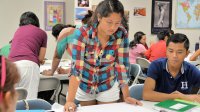A Powerful Way to End the School Year
Year mapping allows students to see what they’ve learned in your class, and it’s a great resource for your incoming class.
Your content has been saved!
Go to My Saved Content.One of our strategies that teachers enjoy using at the end of the school year is a practical, easy-to-use tool we call Celebrating Learning With Year Mapping. This activity gives your current students a chance to feel good about what they’ve learned and provides incoming students an opportunity to see real evidence that they can be successful learners in the coming school year. And it gives teachers a chance to enjoy seeing students share what they’ve learned and to internalize their successful teaching.
Several elements of this strategy make it a powerful way to end the school year with a positive experience, often much needed after testing is over and as a busy year comes to an end. With prompted recall, each student can remember learning events that mean the most to them. Year-end mapping utilizes the power of positive teacher-student relationships as well as personalized learning, summarizing, group learning, and organizing information graphically.
Creating the Presentations
The following steps can be used to create a visual representation of key content studied over the year, which can become a catalyst for celebrating learning successes:
- As the end of the year approaches, tell your students they’ll be using graphic organizers to create a large map of what they’ve learned about the content you’ve taught. (You can find templates for graphic organizers by doing a Google image search for “end of school year graphic organizer.”)
- Guide students in groups of four to work on specific parts of the curriculum, using prompted recall to help them remember important learning events, knowledge, and skills learned during the year.
- Assemble a giant map—a collection of the group maps—ideally on a large wall space of the classroom.
- Ask each student in turn to present one part of the map. These short presentations could include materials that helped them learn, such as books, drawings, pictures, notes, articles, or other meaningful artifacts.
- Rehearse the presentations.
- Invite groups of students who may be in your class next year to come to the presentations and be taught by your current class.
What Students—and Teachers—Get From Year Maps
The year mapping strategy gives teachers a way to relate to individual students around their successful learning—and to revisit some of their own favorite lessons and interactions with students over the past year. It gives students a chance to create fascinating graphic organizers that help them arrange evidence of their year of learning with visual appeal.
The strategy also provides motivation for students to summarize key experiences and knowledge learned throughout the year. Summarizing is a useful learning strategy, as it requires more than retelling. When students summarize, they analyze knowledge, determine key elements, and translate a lot of information into a brief and coherent presentation.
Working in groups often provides an emotional hook that makes the learning experience more meaningful and memorable for students. Group work makes it possible for all students to play a part in making the year-end maps, as individual memories may vary dramatically from student to student. Working together, students can rely on others to remember aspects of the year that may not have been so memorable for them. They in turn remember elements of the curriculum that others may have forgotten.
Questions you can ask your students who are moving up to the next grade include: What were some key things you learned this year? How does this activity make you feel as we pull our giant map together and reflect on what we’ve learned?
At the end of the presentation to students who will be moving up to the grade level you teach, a good question might be: What are you most excited about learning next year?
This strategy can be adapted in a variety of ways. For example, it can be extended to more classrooms across participating grade levels. Some schools have used this strategy to celebrate learning school-wide. Year-end mapping can be successfully paired with other tools we have developed, such as success files—repeatedly updated collections that provide evidence to help students internalize and remember their learning successes.
The power of year mapping is in how it helps both students and teachers internalize learning and celebrate it. Feel free to change the way you use our approach so that it works best for you and your students at this special time of the year.
